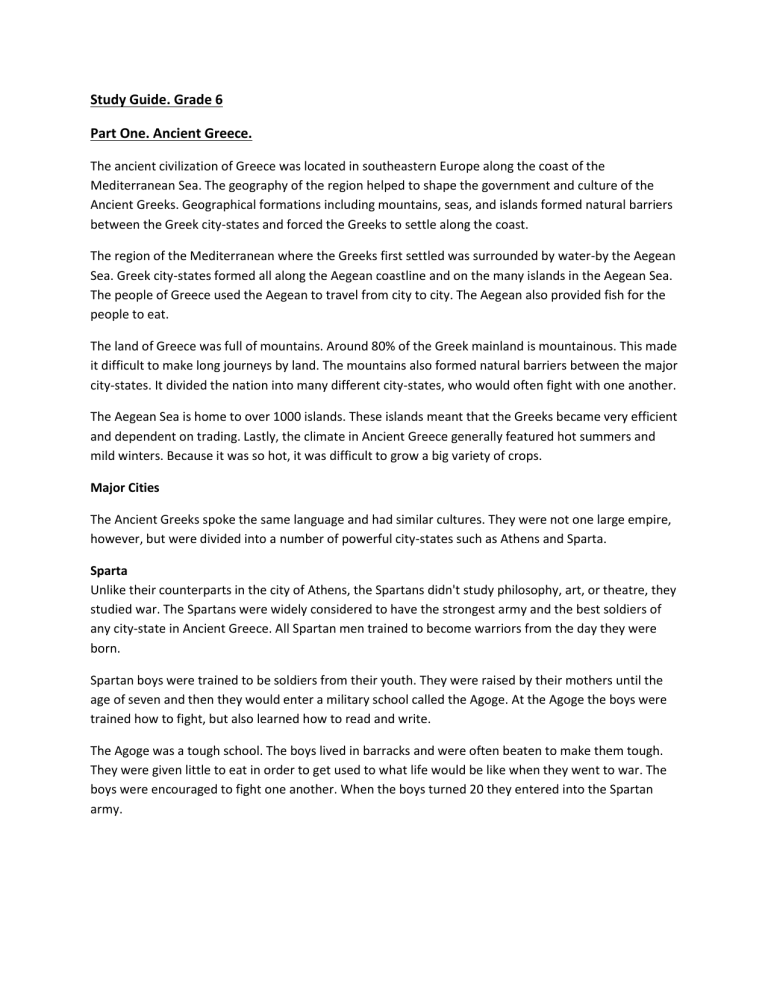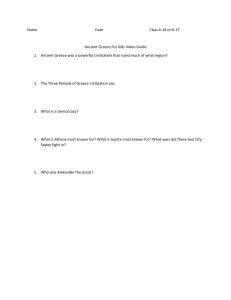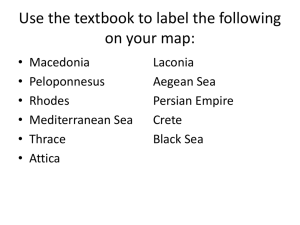
Study Guide. Grade 6 Part One. Ancient Greece. The ancient civilization of Greece was located in southeastern Europe along the coast of the Mediterranean Sea. The geography of the region helped to shape the government and culture of the Ancient Greeks. Geographical formations including mountains, seas, and islands formed natural barriers between the Greek city-states and forced the Greeks to settle along the coast. The region of the Mediterranean where the Greeks first settled was surrounded by water-by the Aegean Sea. Greek city-states formed all along the Aegean coastline and on the many islands in the Aegean Sea. The people of Greece used the Aegean to travel from city to city. The Aegean also provided fish for the people to eat. The land of Greece was full of mountains. Around 80% of the Greek mainland is mountainous. This made it difficult to make long journeys by land. The mountains also formed natural barriers between the major city-states. It divided the nation into many different city-states, who would often fight with one another. The Aegean Sea is home to over 1000 islands. These islands meant that the Greeks became very efficient and dependent on trading. Lastly, the climate in Ancient Greece generally featured hot summers and mild winters. Because it was so hot, it was difficult to grow a big variety of crops. Major Cities The Ancient Greeks spoke the same language and had similar cultures. They were not one large empire, however, but were divided into a number of powerful city-states such as Athens and Sparta. Sparta Unlike their counterparts in the city of Athens, the Spartans didn't study philosophy, art, or theatre, they studied war. The Spartans were widely considered to have the strongest army and the best soldiers of any city-state in Ancient Greece. All Spartan men trained to become warriors from the day they were born. Spartan boys were trained to be soldiers from their youth. They were raised by their mothers until the age of seven and then they would enter a military school called the Agoge. At the Agoge the boys were trained how to fight, but also learned how to read and write. The Agoge was a tough school. The boys lived in barracks and were often beaten to make them tough. They were given little to eat in order to get used to what life would be like when they went to war. The boys were encouraged to fight one another. When the boys turned 20 they entered into the Spartan army. Spartan girls also went to school at the age of seven. Their school wasn't as tough as the boys, but they did train in athletics and exercise. It was important that the women stay fit so they would have strong sons who could fight for Sparta. The women of Sparta had more freedom and education than most Greek city-states at the time. Girls usually were married at the age of 18. They could own land and run households. Athens Athens is one of the great cities of the world. During the time of the Ancient Greeks it was the center of power, art, science, and philosophy in the world. Athens is one of the oldest cities in the world as well, with recorded history going back over 3400 years. It is the birth place of democracy and the heart of the Ancient Greek civilization. Boys only had to devote two years of their lives to the army, from the ages of 18-20. Philosophy, education, literature, art, architecture, and theatre were all extremely important in Athens. Women in Athens had no rights, and were not allowed to do anything without permission from their husbands. Aesop and his Fables Aesop was a slave in ancient Greece and was a great story-teller. He was a keen observer of both animals and people. Most of the characters in his stories are animals, some of which take on human characteristics and are personified in ways of speech and emotions. Aesop uses the qualities and natural tendencies of animals to focus on human traits and wisdom. Each fable has an underlying purpose of teaching us a moral. Questions on Ancient Greece 1. 2. 3. 4. 5. 6. What are the four main characteristics of Ancient Greek geography? How did these four characteristics affect the way Ancient Greek civilizations developed? Compare and contrast the daily life in Sparta and Athens. Write a paragraph comparing the daily life of boys in Sparta/Athens. Write a paragraph comparing the daily life of girls in Sparta/Athens. Who was Aesop? What are his fables? Part Two. Ancient China. The geography of Ancient China shaped the way the civilization and culture developed. The large land was isolated from much of the rest of the world by dry deserts to the north and west, the Pacific Ocean to the east, and impassable mountains to the south. This enabled the Chinese to develop independently from other world civilizations. Perhaps the two most important geographical features of Ancient China were the two major rivers that flowed through central China: the Yellow River to the north and the Yangtze River to the south. These major rivers were a great source of fresh water, food, fertile soil, and transportation. They also were the subjects of Chinese poetry, art, literature, and folklore. The Yellow River is often called the "cradle of Chinese civilization". Early Chinese farmers built small villages along the Yellow River because of its rich, fertile soil. Confucius Confucius (551–479 BC)- teacher, editor, politician, and philosopher. He was born at a time of crisis and violence in China (period of the Warring States) and he hoped his teachings would bring order and peace back to society. He believed in: strong family loyalty, ancestor worship, respect of elders by their children and of husbands by their wives. He based his philosophies around five key relationships that everybody has in their lives. In each relationship EXCEPT for friendship (two equals) there was a superior figure and an inferior figure. But at all times people were meant to respect their role and treat others with politeness and loyalty. His principle "Do not do to others what you do not want done to yourself", was a guideline. Qin Shi Huang The local states of China fought one another during the “Period of the Warring States.” The ruler of the state of Qin took over the neighboring states. He declared himself Qin Shihuangdi and became China’s first Emperor. Qin achieved many things for the Chinese. He unified China, and made it one entire nation. He standardized Chinese language, currency, weights and measurements. He built the great wall of China and created one set of laws and taxes for the nation. He divided the entire nation into 36 different districts, which all had a government official ruling over them. Although he had achieved many things for China, he was a violent and brutal ruler. The massive constructions completed during his time in power (including the Great Wall of China, his palace, and his tomb) caused 100s of thousands of deaths and injuries. If anybody disagreed with his rule, or mentioned rulers of the past, they would be killed as would their family members. He held a festival entitled “The Burning of the Books”; in which all literary and historical works he did not agree with were destroyed. Anybody caught with these books were brandished and punished to four years of working on the Great Wall. Finally, anyone associated with Confucianism or teaching philosophies would be buried alive. Questions 1. 2. 3. 4. 5. 6. 7. 8. 9. What were the two rivers that gave rise to Ancient Chinese Civilizations? Why were these rivers important? What were the main geographical features that acted as borders to Ancient China? What impact did this geography have on the Ancient Chinese civilizations? Who was Confucius? What did he want to achieve, and why? What were the main ideas behind his set of philosophies? Who was the first Emperor of China? What were some of his achievements? 10. Explain, in your own words, whether you think he was a good ruler or not?






